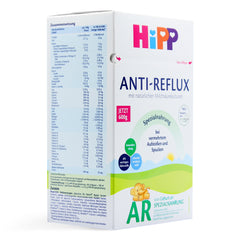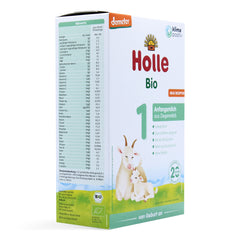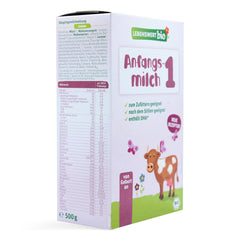Is Adding Rice Cereal to Formula Safe?
46 hours of research 4 minute read

Feeding a baby is a central concern for new parents, and navigating the myriad of feeding options can be overwhelming. One common practice that has persisted over the years is adding rice cereal to a baby's formula. Often suggested by family or even some healthcare providers, this practice is believed to address various issues, such as improving sleep or managing reflux. However, modern pediatric recommendations suggest reevaluating this approach to ensure the safety and well-being of the infant.
Understanding Rice Cereal
Rice cereal is often one of the first solid foods introduced to infants. It is made from rice grains that have been processed into a fine powder, often fortified with essential nutrients like iron. The idea behind adding rice cereal to a baby's bottle is that the thicker consistency can help with issues such as longer sleep periods and reduced reflux. However, it is important to consider the current understanding of infant nutrition and the potential risks associated with this practice.
Historical Context and Evolution of Recommendations
Historically, adding rice cereal to a baby’s bottle was a common recommendation. It was thought to help babies sleep through the night by making them feel fuller for longer periods. Additionally, it was believed to assist in managing gastroesophageal reflux (GER) by preventing milk from coming back up. Despite these intentions, contemporary pediatric advice has shifted due to a better understanding of infant digestive health and nutritional needs.
Modern Pediatric Guidelines
The American Academy of Pediatrics (AAP) advises against adding rice cereal or any solid food to a baby’s bottle before the age of 4-6 months. The AAP recommends exclusive breastfeeding or formula feeding during the first six months of life, followed by a gradual introduction of solid foods. These guidelines are based on extensive research into infant development and nutrition.
Potential Risks of Adding Rice Cereal to Formula
- Choking Hazard: Thickened formula can pose a significant choking risk. Babies may have difficulty sucking and swallowing the altered consistency, increasing the likelihood of aspiration.
- Overfeeding and Obesity: Adding rice cereal can disrupt a baby’s natural ability to regulate their food intake. This may lead to overfeeding, excessive weight gain, and a higher risk of obesity later in life.
- Digestive Issues: Infants under 4-6 months have immature digestive systems. Introducing solids like rice cereal too early can cause constipation and gastrointestinal discomfort.
- Nutritional Imbalance: Rice cereal may dilute the essential nutrients in breast milk or formula, potentially leading to an imbalance in a baby's diet.
Addressing Infant Reflux
A common reason parents consider adding rice cereal to the formula is to manage reflux. While thicker feeds might seem beneficial, the evidence does not support this practice. Instead, pediatricians recommend several strategies to manage reflux effectively:
- Frequent, Smaller Feedings: Offering smaller amounts of milk more frequently can help reduce reflux.
- Upright Positioning: Keeping the baby upright for 20-30 minutes after feeding can help reduce reflux incidents.
- Burping: Burping the baby during and after feedings can help release trapped air, reducing discomfort and reflux.
European Baby Formulas for Managing Acid Reflux
- HiPP Anti-Reflux Formula: HiPP offers a specialized anti-reflux formula that is thicker than regular formula, helping to reduce the occurrence of reflux. It is made with organic ingredients and is gentle on a baby’s digestive system.
- Holle Goat Milk Formulas: Goat milk formula is often easier to digest than cow milk formula, making it a good option for babies with reflux. Holle's goat milk formula is organic and free from artificial additives.
- Lebenswert Bio Organic Formula: This formula is made from organic ingredients and is designed to be gentle on a baby’s stomach. It includes essential nutrients that support healthy digestion and reduce the risk of reflux.
For infants with severe reflux, pediatricians may recommend specific feeding techniques or medications rather than adding rice cereal to the formula.
Appropriate Age for Introducing Solid Foods
Solid foods, including rice cereal, should be introduced at around 6 months of age. Indicators that a baby is ready for solids include:
- Sitting Up with Support: The ability to sit up and hold their head steady.
- Interest in Food: Showing interest in what others are eating and reaching for food.
- Loss of Tongue-Thrust Reflex: No longer pushing food out of their mouth with their tongue.
When introducing solids, it is crucial to start slowly, with small amounts, and observe for any allergic reactions or digestive issues.
How to Introduce Solid Foods to Your Baby
Introducing solid foods is a significant milestone in your baby’s development, marking their transition from a diet of exclusively breast milk or formula to a more varied diet. This phase is essential for meeting their growing nutritional needs and supporting their overall development. Here’s a fresh and unique guide to help you navigate this exciting time with your little one.
Selecting First Foods
When introducing solids, start with foods that are gentle on your baby’s digestive system and unlikely to cause allergic reactions. Here’s a unique approach to selecting first foods:
- Fortified Cereals: Begin with single-grain cereals, such as rice or oatmeal, fortified with iron. Mix these with breast milk or formula for added nutrition.
- Vegetable Purees: Offer pureed vegetables like carrots, squash, or sweet potatoes. These are rich in vitamins and easy to digest.
- Fruit Purees: Introduce fruits such as apples, pears, or bananas, which are naturally sweet and well-tolerated.
- Meat Purees: As your baby adjusts to solids, try pureed meats like chicken or beef, which are excellent sources of protein and iron.
Introducing New Foods Gradually
To monitor how your baby responds to new foods:
- Introduce One Food at a Time: This helps to identify any potential food allergies or intolerances.
- Start Small: Begin with small portions and increase gradually as your baby becomes accustomed to the new tastes and textures.
- Monitor Reactions: Watch for any adverse reactions such as rashes or digestive issues.
Adjusting Texture and Consistency
Start with smooth purees and gradually transition to more textured foods. By around 8-10 months, your baby may be ready for finely chopped foods and even soft finger foods, which can enhance their chewing skills.
Making Mealtimes Enjoyable
Creating a positive mealtime experience can encourage healthy eating habits:
- Offer a Variety: Provide a range of foods to expose your baby to different flavors and textures.
- Eat Together: Share meals with your baby to model healthy eating behaviors.
- Encourage Exploration: Allow your baby to explore food with their hands, which supports their motor skills and self-feeding abilities.
Managing Allergies and Food Sensitivities
Introducing new foods can raise concerns about allergies. Common allergens include peanuts, eggs, and dairy. If you have a family history of allergies or if your baby shows signs of food sensitivities, consult your pediatrician for personalized guidance on introducing these foods.
Ensuring Safety
Proper food preparation and safety are crucial:
- Avoid Honey: Honey should not be given to babies under one year due to the risk of botulism.
- Check Food Temperature: Always ensure food is at a safe temperature before offering it to your baby.
- Be Aware of Choking Hazards: Avoid foods that pose choking risks, such as whole grapes or large chunks.
By following these guidelines, you can support your baby’s transition to solid foods effectively and safely, laying the groundwork for healthy eating habits.
Although adding rice cereal to a baby’s formula was a common practice in the past, current pediatric guidelines advise against it. The risks, including choking, overfeeding, digestive issues, and nutritional imbalance, outweigh the perceived benefits. Instead, focus on exclusive breastfeeding or formula feeding for the first 6 months, and then gradually introduce solid foods safely.
For managing reflux and ensuring your baby gets the right nutrition, consult with a pediatrician for personalized advice and recommendations. Parents often seek guidance on adding rice cereal to formula, including how to mix rice cereal with formula in a bottle and how to add rice cereal to formula effectively. Remember, every baby is unique, and what works for one may not work for another. Prioritizing your baby's health and safety is the key to making informed feeding decisions.
By following these guidelines and choosing high-quality products like those offered by Organic Life Start, you can ensure that your baby receives the best possible nutrition and care, laying a strong foundation for their growth and development.
Most Popular European Baby Formulas for Managing Acid Reflux
Organic Life Start is committed to providing accurate, reliable, and trustworthy information to parents and caregivers. We carefully choose credible sources and follow a meticulous fact-checking process to uphold the highest standards in infant nutrition and parenting advice. To learn more about our dedication to accuracy, please explore our editorial guidelines.
Link To Sources











Jamie L -
Does anyone have a good alternative to adding rice cereal to formula to help with baby’s reflux or sleep struggles? I tried using slower-flow nipples and more upright holding after feeds, and that seemed to help settle my little one without adding extra thickeners. We also found that pacing feeds and gentle tummy massages made a noticeable difference in comfort. Would love to hear what’s worked for others!
Khalid T -
November 24, 2025
I always get nervous about whether adding anything to a bottle is actually safe, especially with choking risks. It helps knowing other parents wonder the same thing.
Frederick C. -
October 25, 2025
I was wondering if it would be possible to make Elio’s Holle Goat formula fuller by adding rice cereal, but our pediatrician was totally against the notion. She warned that it might cause gastrointestinal issues and perhaps cause choking. I’m really glad I asked her first — it’s reassuring to know that sticking with plain Holle Goat milk is the safest choice for him.